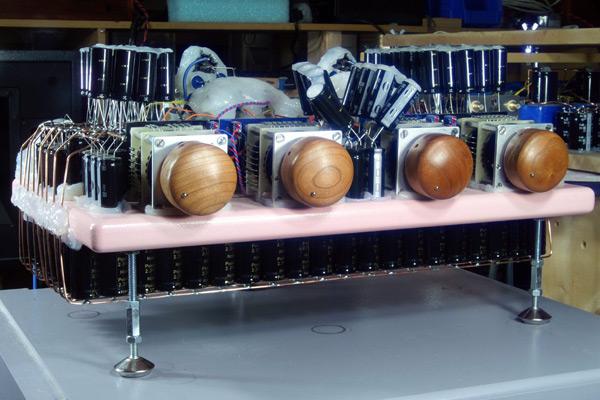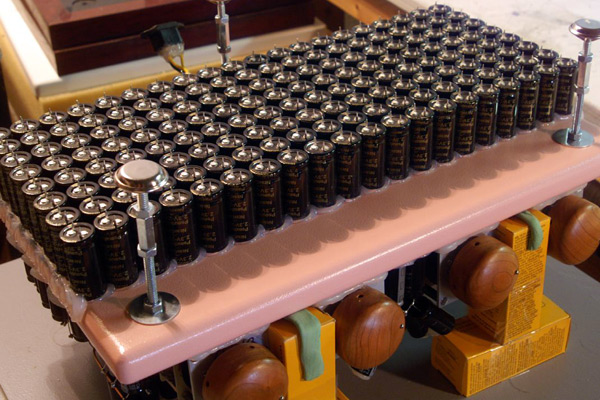 |
||
| July 1, 2008 Searching for the Extreme: Gilbert Yeung of Blue Circle Audio -- Part One Gilbert Yeung is a sort of audio iconoclast whose products challenge conventional wisdom, and seem to create markets where there were none before. For instance, his Pinkie Project preamplifier uses massive capacitor banks much like batteries -- it can run on a single charge for over 50 hours. As if that weren’t surprising enough, how Yeung then charges the Pinkie is even more original: anything that can output 12-16V DC can be used. He uses a solar panel, but a car battery, a windmill -- even a car dashboard’s 12V cigarette-lighter socket -- will work. In Yeung’s words, he’s "off the grid." And maybe off his rocker. As I wrote this, Yeung was readying the launch of a series of all-solid-state preamplifiers based on the Pinkie Project, and a new line of power amps based on that circuit design. The new preamp line begins with a base model; the buyer can then upgrade that base unit with plug-in Capacitor Packs. As capacitance is added, sound quality and length of operating time increase. The base preamp model is the BC109 ($3695 USD), which can be upgraded with the Capacitor Pack 1, or CP1 ($2995), and then the CP2 ($4995). The BC109 can also be purchased with the CP1 or both upgrades already installed, as the BC109 CP1 ($6690) or BC109 CP2 ($11,685). The new power-amp line begins with the BC108 ($19,995), to be followed later by three slightly scaled-down models: the BC106, BC104, and BC102 (prices to be announced). These will be higher-powered amplifiers than have typically been seen from Blue Circle Audio.
With the announcement of these new lines, I thought it would be a good time to ask Yeung a few questions about his unique design strategy. One of the most obvious things to be noted from a perusal of the product descriptions at www.bluecircle.com is that a great deal of importance is placed on the components’ power supplies. Amplifiers, preamplifiers, D/A converters -- all have supplies that look as if they could run a small nuclear reactor. I asked Yeung to explain why the power supply is so critical, specifically for power amplifiers: "The power supply, as far as I’m concerned, is the most important part of the entire amp. The speaker sees the output impedance of an amp, and that output impedance is directly related to the output impedance of the power supply. Without the low output impedance of a power supply to back it up it doesn’t matter how low the theoretical output impedance of an amp’s output devices is -- it will not support the musical demands placed on it. Every time there’s a demanding musical passage, it draws current from the amp. If the power supply can’t hold up all the way through that demanding passage, it will collapse. That’s one of the main reasons I pay so much attention to power-supply design, and pack in as much capacitance as cost and other factors will allow." I asked Yeung to explain more about how generous amounts of power-supply capacitance benefit an amplifier, both technically and sonically. "It all starts at the wall. AC power coming from the wall outlet is good enough for most purposes. We have 120V/60Hz in North America and 240V/50Hz in other places in the world. It is an alternating waveform, supposedly. These days, it is very difficult to get clean power. Some audiophiles use external power-line filters and conditioners. Internal AC line filters can also be incorporated. "AC power goes through the power cord and into the amplifier, through the internal wires, and passes through a fuse, a power switch, and then on to the primary winding of the transformer. Typical power transformers are designed to pass through 60Hz. Ideally, the transformer has the effect of a low-pass filter, but in real life some noise still gets through the transformer. Sometimes it can be heard as a tick and a small pop through the speaker. These are usually caused by heavy appliances being turned on and off. "After the transformer, a rectifier is supposed to flip the negative waveform into positive. Consider the positive supply rail: The ripple voltages go from alternating 60 times per second to 120 times per second. Every time the waveform goes up from 0V, it charges the capacitor bank. Every time the waveform goes down, the capacitor banks are supposed to hold on to the voltage until the next charging waveform comes around. Those capacitors are also supposed to supply the needs of the audio circuit. If the capacitors are being drained too low and the next charging waveform has not yet come along, that’s when the capacitors -- the power supply -- starts to collapse. "When a power supply collapses, ripple voltages are higher, and some humming passes through into various stages of the amp. Remember that the power supply is charged 120 times per second in a 60Hz power line and 100 times per second in a 50Hz power line. If the ripples get severe, the amplifier circuit must adjust 120 times per second. That puts more demand on the circuit when the circuit itself is already being drained by the demanding musical passage. The results are that transients slow down and the sound becomes muddy, bright, and harsh. You’ll hear a narrow soundstage and very boxy, closed-in sound. But if the power supply holds up through the demanding musical passage, it can give the circuit a smooth ride -- much like when you’re driving a V8-powered auto pulling a trailer with two horses in it. With an inadequate power supply, it will be like pulling that horse trailer with a small car with a four-cylinder engine. "As we can see, a simple power supply consists of a power switch, a fuse, a transformer, a rectifier, and a bank of capacitors. The weakest link is always the number of capacitors the engineer is allowed to install, limited by such factors as the physical size of the chassis and the cost of parts and labor. As of today, I have not found the limit of the capacitors I can install in a power amp or preamp without hearing additional improvement. Just today, I installed another 25 farads’ worth of capacitors in my Pinkie Project preamp, which already had 350 farads. There is still improvement to be gained from 350 to 375 farads."
When I asked Gilbert Yeung how his Blue Circle components differ from other products on the market whose power supplies have not received such close attention, he replied in his usual blunt fashion: "Some designers purposely design a small, so-called ‘controlled’ power supply to ‘tune’ an amplifier to their liking. A designer can use a power supply to choke the sound. Depending on how it is designed, it can produce a certain sound, which is often called a ‘sonic signature.’ It usually makes almost everything sound about the same. If an amplifier has it own signature sound, this has a filter effect, and sometimes can filter out the bad and modify the rest to make it listenable. But that approach is short-term thinking, and I have never liked it. I would rather design an amp that has no sound of its own. Then, whatever music passes through such an amp will sound more like the original recording. It is difficult and costly, but not impossible." Look for an article on Blue Circle Audio’s new BC108 power amplifier later in the year. . . . Jeff Fritz
Ultra Audio is part of the SoundStage! Network. |

